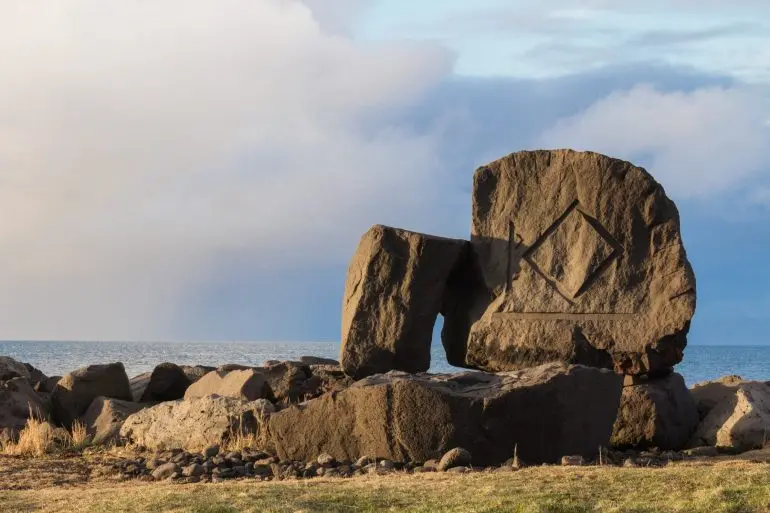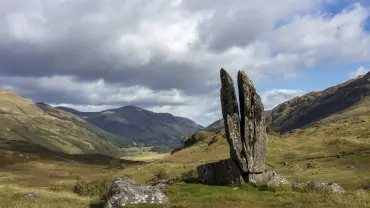In the simplest terms, runes are the characters of ancient Germanic alphabets. There were many variations of runes amongst different Germanic peoples and these variations also changed over time. However, when most people think of runes, it is Norse runes they have in mind, and specifically, the rune symbols of the Viking age.
Mostly dating from the late 8th to the early 12th centuries, these symbols represent some of the most important clues as to the history of the Nordic people. Perhaps the best known examples from the time are viking rune stones. However, later medieval examples from the 14th century onwards were carved into graves, weapons, jewellery and any number of everyday items.
So, what were the Nordic runes? What did the rune symbols mean? And what messages did they leave behind? Read on as we decipher the facts.
The Origins of Rune Stones

Old Germanic runes (Photo: HalliHuberts via Getty Images)
The exact origins of the runic alphabet are not known, but it’s generally accepted that it derived from the early Mediterranean scripts around the first century AD. For example, there are similarities to the Phoenician alphabet with its angular letter shapes. These became the trademark of the Nordic runes. The development of the script may also have been influenced from early Germanic sacred symbols found in northern European rock carvings.
Norse Symbols: A Changing Alphabet

Elder Futhark Runes engraved on stones (Photo: KatyaSuresh via Getty Images)
The Norse runes are the alphabet of the Old Norse language. That alphabet was called futhark. As far as we know, it originated in around the 1st century AD, varying by region and evolving over time.
In general terms, there were two main types of Norse runes: the earlier and more complex Elder Futhark, and the subsequent Younger Futhark. It is Younger Futhark that is associated with the Viking Age. Its rune symbols were far simpler and easier to carve, consisting of 16 characters or “staves”.
The Multiple Meanings of Nordic Runes

Nordic symbolism (Photo: Marco Klaue via iStock)
There are clear similarities between futhark and our modern alphabet. Like the letters we use today, each character represented sound values, like consonants and vowels. However, Norse runes were slightly more complex than our ABC. They were also ideographs, meaning they were used to represent concepts. Modern examples of ideographs include emojis and street signs.
Translating Norse Symbols

Viking runic inscription (Photo: DEA / G. DAGLI ORTI via Getty Images)
For almost two thousand years, the meaning of Norse symbols has been discussed, deliberated and debated by experts. They have been used in a number of different ways by different communities and cultures so it’s only natural that names and meanings will vary.
Here is the most widely accepted list of letters and meanings of the famous Norse runes –
A | Ansuz
Sound – aa, as in far | Meaning – truth, wisdom, god, communication, inspiration
B | Berkan/Berkanan
Sound – be, as in bee | Meaning – birch tree, fertility, birth, growth, new start
C | Cen/Caunan/Kenaz
Sound – kay, as in okay | Meaning – torch, illumination, creativity, fire, transformation
D | Dagaz
Sound – dee, as in melody | Meaning – day, new dawn, awakening, awareness, breakthrough
E | Ehwaz\Eihwaz
Sound – short e, as in bend | Meaning – cooperation, discovery, trust, teamwork
F | Fehu
Sound – eff, as in frank | Meaning – achievement, wealth, money earned, luck
G | Gebo
Sound – hard gee, as in great | Meaning – exchanging gifts, love, partnership
H | Hagalaz
Sound – aitch, as in hurry | Meaning – destruction, radical change, loss, transformation
I | Isa/Isaz
Sound – short i, as in limp | Meaning – inertia, stasis, self-control, concentration
J | Jera
Sound – soft j/y as in year | Meaning – cycles, time, peace, rewards, prosperity
K | Kaun|Kenaz
Sound – hard c/k, as in click | Meaning – illumination, fire, transformation, regeneration
L | Laguz
Sound – ell, as in lemon | Meaning – dreams, emotion, the unconscious mind, fantasy
M | Mannaz
Sound – emm, as in minute | Meaning – humankind, collective effort, connectivity
N | Naudiz/Nauthiz
Sound – enn as in none | Meaning – survival, basic human needs, endurance, hardship
O | Othila\Othala
Sound – short oh, as in drop | Meaning – inheritance, ancestors, home, legacy
P | Perthro\Peorth
Sound – pee, as in penny | Meaning – fate, destiny, mystery, uncertainty, secrets
R | Raido
Sound – arr, as in rope | Meaning – personal direction, journeys, wheels, travel
S | Sowilo\Sowulo
Sound – ess, as in soup | Meaning – health, energy, success, wholeness
T | Tiwaz
Sound – tee, as in tiny | Meaning – righting of wrongs, justice, honour, victory
TH | Thuriaz/Thurisaz
Sound – th, as in third | Meaning – breaking barriers, solving problems, protection
U | Uruz
Sound – ooh, as in brood | Meaning – ultimate strength, power, courage, endurance
W | Wunjo
Sound – w, as in wind | Meaning – joy, friendship, celebration, fellowship
Z | Algiz
Sound – zed, as in zoo | Meaning – courage, divine protection, self-defence
NG | Ingwaz
Sound – ng, as in sing | Meaning – concentrated energy, unity, agreement, harmony
Famous Runes and Viking Rune Stones

Monument erected by King Harald honouring his parents (Photo: DE AGOSTINI PICTURE LIBRARY / via Getty Images)
The earliest runic inscriptions are potentially from around 50 AD on what is known as the Meldorf brooch. It is a beautifully jewelled brooch typically used for fastening clothes at the right shoulder and is thought to have come from a cremation grave site. Found close to the Danish border in the German town of Meldorf, experts to this day remain split as to whether the inscription is Roman script or rune symbols.
The Vimose Comb dating from around 160 AD, literally a small hair comb found in the town of Vimose on the Danish island of Funen, is the earliest unambiguous representation of runic symbols and is carved with the word ‘harja’. Dating from around the same time, an iron spearhead found at the Øvre Stabu farm in Oppland, Norway, is inscribed with Norse runes from the Elder Futhark alphabet.
As for viking rune stones, some of the most famous have been found in the Danish town of Jelling. In particular, the two large 10th century stones, the first erected by King Gorm the Old commemorating his wife and the second by his son, Harald Bluetooth, in memory of his father.
Rune Symbols Today

A beautifully decorated Viking runestone ( Photo: Lars Johansson / EyeEm via Getty Images)
Rune symbols continued to be used in Scandinavia for centuries after the end of the viking age, with some reportedly as late as the 19th century. And viking rune stones remain popular today both in the study of ancient languages and in fantasy games.












